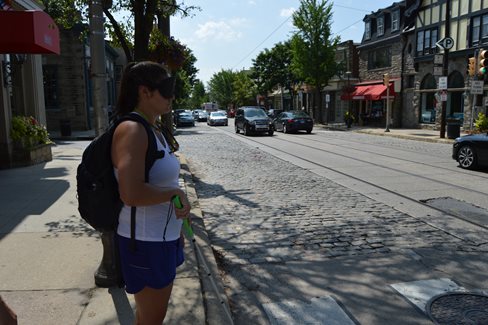The loss of vision frequently brings the inability to carry out everyday activities required for living independently. As a result, Salus University College of Education and Rehabilitation (CER) goes above and beyond in order to educate students in the field of Blindness and Low Vision studies. To better understand the increased needs and challenges of current and future clients, students from the University’s Master of Science degree program in Orientation and Mobility (O&M) are educated in safe and independent travel through a unique blend of online classes, lectures, and practical fieldwork, exposing them to a truly comprehensive experience. This type of hands-on training takes place on-campus, in busy, local neighborhoods, and other areas where safe travel may be a concern.
 Through June, it’s typical to witness groups of blindfolded students being guided and instructed through Salus hallways using white canes in order to master their interior mobility skills. Once instructors feel confident in each student’s navigation abilities, training is then moved to parking lots and local neighborhoods.
Through June, it’s typical to witness groups of blindfolded students being guided and instructed through Salus hallways using white canes in order to master their interior mobility skills. Once instructors feel confident in each student’s navigation abilities, training is then moved to parking lots and local neighborhoods.
With a blindfold positioned over her eyes shutting out the bright July sun, student Rolanda Fleurival’s sense of sight was completely eliminated, as the smell of exhaust and humming car engines became more intense. After taking one last deep breath, Fleurival grasped her white cane, and set down bustling Germantown Avenue in the Chestnut Hill section of Philadelphia.
“The name of the game is alignment – remember to stay within your parallel,” repeated Dr. Fabiana Perla, director of the O&M program and chair of the Department of Blindness and Low Vision Studies, as she instructed Fleurival across the busy intersection of Willow Grove and Germantown Avenues. Maintaining a watchful eye, Dr. Perla offered advice and instruction while inspecting the environment for unforeseen complications, such as a change in traffic. Students Alex Skavlem and Todd Birchard observed as Fleurival analyzed the intersection, identified traffic patterns, and successfully crossed the hectic intersection. “This is an incredibly challenging task,” Fleurival commented. “You paint a picture in your mind of what the intersection might look like, then all of a sudden traffic shifts and that depiction is thrown out the window,” she said. “This experience truly places you in the shoes of potential clients.”
 A few streets down, student Emilie Taylor used her white cane to ensure she had adequate time to avoid obstacles in her path. Jamie Maffit, assistant professor, instructed Melanie Johnson to find her parallel before setting across the off-set intersection, which included a one-way street and recessed curbs. Taylor passed her white cane back and forth, which allowed her to detect cracks in the cobblestone crosswalk. “This type of training provides first-hand experience and empathy to help understand how blind or visually impaired individuals feel,” said Johnson. “You need to understand and listen for your cues in order to fully trust yourself to navigate this otherwise risky situation.”
A few streets down, student Emilie Taylor used her white cane to ensure she had adequate time to avoid obstacles in her path. Jamie Maffit, assistant professor, instructed Melanie Johnson to find her parallel before setting across the off-set intersection, which included a one-way street and recessed curbs. Taylor passed her white cane back and forth, which allowed her to detect cracks in the cobblestone crosswalk. “This type of training provides first-hand experience and empathy to help understand how blind or visually impaired individuals feel,” said Johnson. “You need to understand and listen for your cues in order to fully trust yourself to navigate this otherwise risky situation.”
This type of real-life training not only helps students gain the critical skills and experience needed to convey information to their future clients, but also provides them with an understanding of what visually impaired individuals experience on a daily basis. This specialized form of training allows Salus students to live what they teach – by walking a mile in their clients’ shoes.